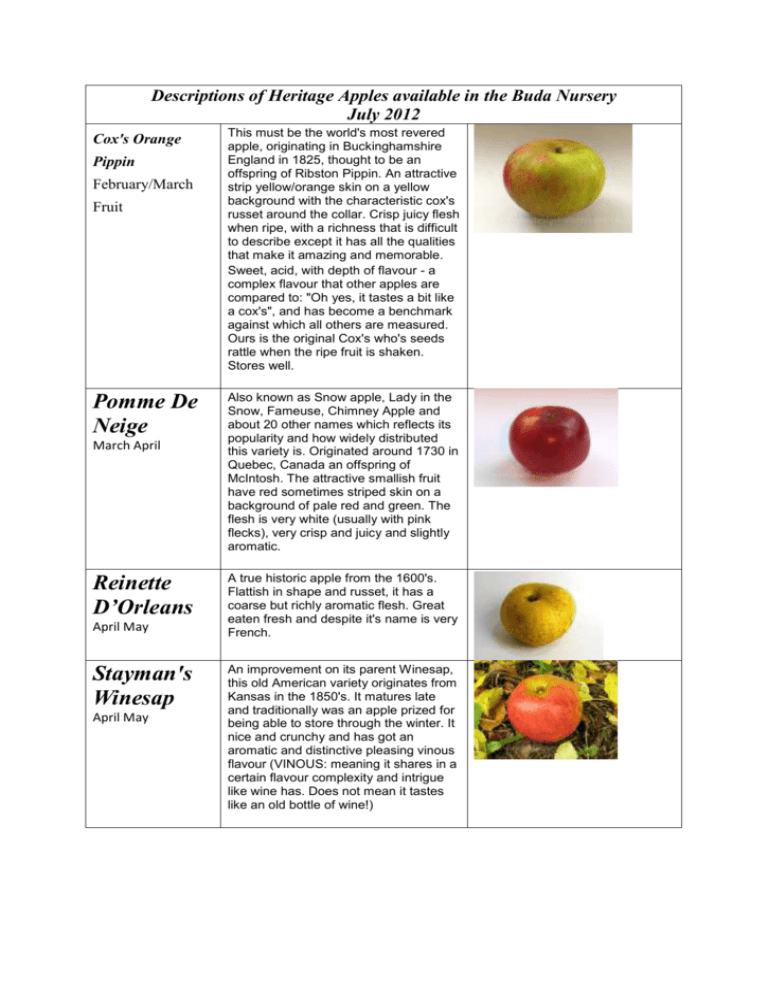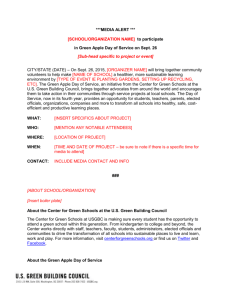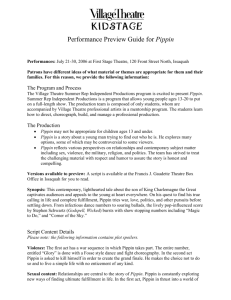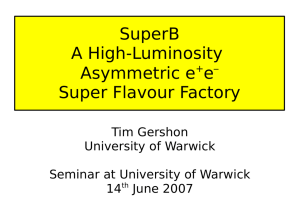Sturmer Pippin
advertisement

Descriptions of Heritage Apples available in the Buda Nursery July 2012 Cox's Orange Pippin February/March Fruit Pomme De Neige March April Reinette D’Orleans April May Stayman's Winesap April May This must be the world's most revered apple, originating in Buckinghamshire England in 1825, thought to be an offspring of Ribston Pippin. An attractive strip yellow/orange skin on a yellow background with the characteristic cox's russet around the collar. Crisp juicy flesh when ripe, with a richness that is difficult to describe except it has all the qualities that make it amazing and memorable. Sweet, acid, with depth of flavour - a complex flavour that other apples are compared to: "Oh yes, it tastes a bit like a cox's", and has become a benchmark against which all others are measured. Ours is the original Cox's who's seeds rattle when the ripe fruit is shaken. Stores well. Also known as Snow apple, Lady in the Snow, Fameuse, Chimney Apple and about 20 other names which reflects its popularity and how widely distributed this variety is. Originated around 1730 in Quebec, Canada an offspring of McIntosh. The attractive smallish fruit have red sometimes striped skin on a background of pale red and green. The flesh is very white (usually with pink flecks), very crisp and juicy and slightly aromatic. A true historic apple from the 1600's. Flattish in shape and russet, it has a coarse but richly aromatic flesh. Great eaten fresh and despite it's name is very French. An improvement on its parent Winesap, this old American variety originates from Kansas in the 1850's. It matures late and traditionally was an apple prized for being able to store through the winter. It nice and crunchy and has got an aromatic and distinctive pleasing vinous flavour (VINOUS: meaning it shares in a certain flavour complexity and intrigue like wine has. Does not mean it tastes like an old bottle of wine!) Bramley's Seedling April May Peasgood's Nonsuch April May Egremont Russet April May Laxton Superb May England's most popular cooking apple and for good reason - when cooked produces a puree that is unsurpassable both in texture and flavour. It has a firm tart acid flesh, with green skin flushed brownish-red on the sunny side. The fruit are large in size with a slightly irregular shape. Stores very well. A huge apple of almost grapefruit size. The flesh abundant, very sweet, cooks well and is great for eating. Definitely share it with someone Probably originated in England in the 1870's. It has a characteristic russet yellow skin, sometimes with a patch of red when ripe. A rich, crunchy flesh with an almost a nutty flavour. Keeps well. Laxton Superb apple trees produce an apple that is a really good eater with an understated red and green skin and sweet, firm flesh - of the sort that sometimes seems to taste better cut than bitten. Although it was first introduced well over 100 ago, and many more modern apples have been bred since then, Laxton Superb trees crop beautifully and their fruit is still one of the tastiest apples you can grow. It is a late flowering pollinator and is selffertile. In other words a Laxtons Superb apple tree will produce some fruit if planted alone, but will always crop better in the company of another pollinator. Sturmer Pippin May Sturmer Pippin was discovered in the early 19th century in England, and became an important variety in the Victorian period. It is an excellent keeper - an important quality in the era before refrigeration was widespread. When picked in late autumn the flavour is sharp and acidic - ideal for those who like a sour apple. It mellows and sweetens during storage, to become the perfect winter apple. The acidic flavour and dense flesh is reminiscent of Granny Smith, although it is not thought to be related.







